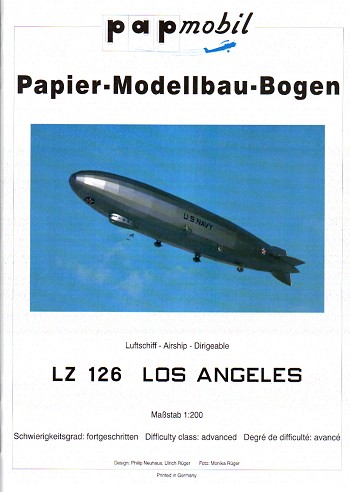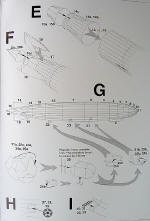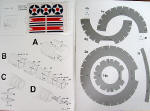|
KIT: |
Papmobile 1/200 ZR-3 'USS Los
Angeles' |
|
KIT #: |
|
|
PRICE: |
$13.75 MSRP |
|
DECALS: |
One option |
|
REVIEWER: |
Les Dorr Jr |
|
NOTES: |
It's a 39" long card model |
 While I know a fair amount about U.S.
Navy “Golden Age” aircraft, my knowledge about the use of airships is
pretty slim. The Navy’s history website has some excellent information
about the dirigible USS Los Angeles (www.history.navy.mil/photos/ac-usn22/z-types/zr3.htm),
so allow me to quote from there:
While I know a fair amount about U.S.
Navy “Golden Age” aircraft, my knowledge about the use of airships is
pretty slim. The Navy’s history website has some excellent information
about the dirigible USS Los Angeles (www.history.navy.mil/photos/ac-usn22/z-types/zr3.htm),
so allow me to quote from there:
“USS Los Angeles, a 2,472,000
cubic foot rigid airship, was built at Friedrichshafen, Germany. Her
construction was partially funded by German World War I reparations and was
conditional on her being employed for "civil" purposes. Completed in August
1924 under the builder's number LZ-126, she departed Germany in
mid-October 1924 for delivery to the U.S. Navy. After a three day
trans-Atlantic flight, the airship arrived at Naval Air Station Lakehurst,
New Jersey, where her hydrogen lifting gas was replaced with non-flammable
helium. This greatly increased her safety, but also significantly reduced
her payload and range. In late November 1924 she was placed in commission
as USS Los Angeles and began several years of flight activity to
explore the potential of her type for commercial and Naval use. Between
February and May 1925, she voyaged twice to Bermuda and one time to Puerto
Rico, and made test moorings to the Navy's floating airship base, the oiler
Patoka.
In June 1925, Los Angeles
began an overhaul at Lakehurst, while her expensive helium gas was
transferred to the older dirigible Shenandoah (ZR-1). The latter's tragic
loss, on 3 September 1925, produced a temporary shortage of helium,
delaying Los Angeles' return to flight service until March 1926.
However, she was actively employed for six years after that, five of them
as the Navy's only rigid airship. During this time, in addition to her
normal training and experimental duties, she was used to calibrate East
Coast radio compasses, made several cross-country flights around the
eastern and southern United States, landed briefly on the aircraft carrier
Saratoga and continued her work with Patoka. A unique
incident on 25 August 1927, in which she briefly rose tail-high to a
near-vertical position while attached to Lakehurst's tall mooring mast,
demonstrated the dangers inherent with this type of facility and led to the
adoption of the "stub" mast used for more than three more decades of
dirigible and blimp operations.
Also in 1927, Los Angeles began a
series of operations that developed techniques for basing airplanes on
board airships, a concept that promised to greatly expand the dirigible's
potential for fleet scouting. In the winter of 1931, with her ‘civil use’
restrictions diplomatically eased, she flew to Panama to participate in
Fleet Problem XII, the first time an airship had taken part in a major U.S.
Fleet exercise since 1925. Later in 1931 she operated for a short time with
the new USS Akron (ZRS-4), a much larger dirigible whose design owed
much to Los Angeles's work. At the end of June 1932, she was
decommissioned and placed in preservative storage in Lakehurst's airship
hangar. Following reconditioning in 1934, she began three years of
non-flying experiments, including open-air moorings. Los Angeles
left her hangar for the last time in November 1937 and, in October 1939,
was stricken from the Navy list and began the dismantling process. Within a
few months, USS Los Angeles, the most successful of the Navy's rigid
airships, had been reduced to scrap.”

 The “kit” comes
“packaged” in a booklet containing 16 pages 8 ½ x 11” pages of parts, plus
two pages of instructions. Everything is printed on heavy card stock, with
the airship parts a realistic-looking flat aluminum color. The parts aren’t
laser-cut or otherwise scored. Cutting them out is left to the modeler, so
the fit will be what you make it. The cylindrical fuselage sections are
reinforced by top and bottom strips. A circular piece with tabs connects
each section.
The “kit” comes
“packaged” in a booklet containing 16 pages 8 ½ x 11” pages of parts, plus
two pages of instructions. Everything is printed on heavy card stock, with
the airship parts a realistic-looking flat aluminum color. The parts aren’t
laser-cut or otherwise scored. Cutting them out is left to the modeler, so
the fit will be what you make it. The cylindrical fuselage sections are
reinforced by top and bottom strips. A circular piece with tabs connects
each section.
The major fuselage
pieces have horizontal fold lines printed on them – remember, the Los
Angeles was a huge gasbag of fabric laid over complex metal framing –
but they are on the printed side of the parts. Unless I’m missing
something, that’s means you’ll basically have to fold the parts
inside out, then assemble them with the printed side outward.
The gondola, fins
and engine pods are all separate pieces. Windows are represented in black.
The propellers are simple, flat pieces of card. Intermediate modelers
probably will want to add some detail to the pods and scratchbuild 3-D
props. The national insignia and fin stripes are provided as stickers that
must be cut out. The ship’s name and “U.S. NAVY” markings are preprinted on
the parts.
The instructions
pages are almost totally visual, with just a couple callouts in both
English and German.
To paraphrase Chief
Brody in the movie Jaws, “You’re gonna need a bigger shelf….”
Some plastic
modelers may sniff at this kit and say, “It’s just a paper model.” Not
hardly. The instructions are deceptively simple. This thing looks every bit
as formidable (at least, to me) as a large vacuform kit. It also will be a
challenge to figure out how to mount the finished Los Angeles to a
base, since it’s so big yet there’s nothing inside it.
The booklet notes
that the difficulty class is “advanced.” I, for one, plan to hone my skills
on one of the free dirigible card models offered by Currell Graphics (http://www.currell.net/models/mod_free.htm).
August 2005
If you would like your product reviewed fairly and quickly by a
site that has around 300,000 visitors a month, please
contact
me or see other details in the
Note to
Contributors.
Back to the Main Page
Back to the Previews Index Page
 While I know a fair amount about U.S.
Navy “Golden Age” aircraft, my knowledge about the use of airships is
pretty slim. The Navy’s history website has some excellent information
about the dirigible USS Los Angeles (www.history.navy.mil/photos/ac-usn22/z-types/zr3.htm),
so allow me to quote from there:
While I know a fair amount about U.S.
Navy “Golden Age” aircraft, my knowledge about the use of airships is
pretty slim. The Navy’s history website has some excellent information
about the dirigible USS Los Angeles (www.history.navy.mil/photos/ac-usn22/z-types/zr3.htm),
so allow me to quote from there:
